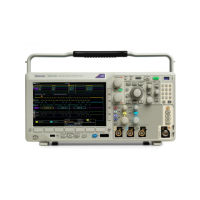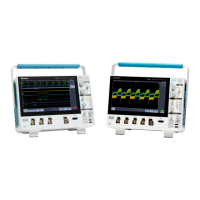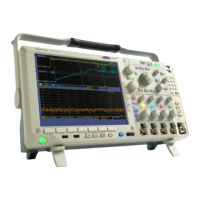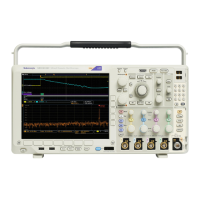Status and Events
Example of Using the
BUSY Query
The BUSY? query
allows you to find out whether the oscilloscope is
busy processing a command that has an extended processing time such as
single-sequence acquisition.
The same command sequence, using the BUSY? query for synchronization, looks
like this:
/* Set up conditional acquisition */
ACQUIRE:STATE OFF
SELECT:CH1 ON
HORIZONTAL:RECORDLENGTH 1000
ACQUIRE:MODE SAMPLE
ACQUIRE:
STOPAFTER SEQUENCE
/* Acqu ire waveform data */
ACQUIRE:STATE ON
/* Set up the measurement parameters */
MEASUREMENT:IMMED:TYPE AMPLITUDE
MEASUREMENT:IMMED:SOURCE CH1
/* Wait
until t he acquisition is com plete before taking
the mea surement */
While B USY? keep looping
/* Take amplitude measurement */
MEASUREMENT:IMMED:VALUE?
This sequence lets you create your own wait loop rather than using the *WAI
command. The BUSY? query helps you avoid time-outs caused by writing too
many commands to the input buffer. The controller is still tied up though, and
the
repeated BUSY? query will result in bus traffic.
Messages
The information contained in the topics above covers all the programming
interface messages the oscilloscope generates in response to commands and
q
ueries.
For most messages, a secondary message from the oscilloscope gives detail about
the cause of the error or the meaning of the message. This message is part of the
message string and is separated from the main message by a semicolon.
Each message is the result of an event. Each type of event sets a specific bit inthe
SESR and is controlled by the equivalent bit in the DESER. Thus, each message
is associated with a specific SESR bit. In the message tables, the associated SESR
bit is specified in the table title, with exceptions noted with the error message text.
No Event
The following table shows the messages when the system has no events or status
to report. These have no associated SESR bit.
MDO4000/B/C, MSO/DPO4000B and MDO3000 Series Oscilloscopes Programmer Manual 3-13

